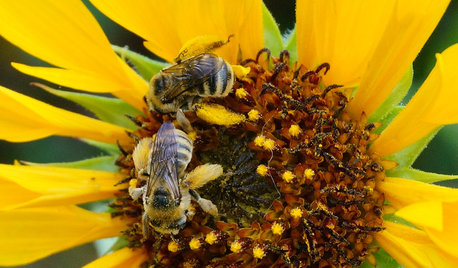Please help! Carpender Bees
TexasCoon
19 years ago
Related Stories

EARTH DAY12 Entertaining ‘Bee-haviors’ of Native Bees
The parade of pollinator antics is another reason to create a garden that nurtures native bees
Full Story
GARDENING GUIDESGreat Design Plant: Ceanothus Pleases With Nectar and Fragrant Blooms
West Coast natives: The blue flowers of drought-tolerant ceanothus draw the eye and help support local wildlife too
Full Story
GARDENING GUIDESGreat Design Plant: Silphium Perfoliatum Pleases Wildlife
Cup plant provides structure, cover, food and water to help attract and sustain wildlife in the eastern North American garden
Full Story
HOME OFFICESQuiet, Please! How to Cut Noise Pollution at Home
Leaf blowers, trucks or noisy neighbors driving you berserk? These sound-reduction strategies can help you hush things up
Full Story
EARTH DAYHow to Design a Garden for Native Bees
Create a garden that not only looks beautiful but also nurtures native bees — and helps other wildlife in the process
Full Story
SUMMER GARDENINGHouzz Call: Please Show Us Your Summer Garden!
Share pictures of your home and yard this summer — we’d love to feature them in an upcoming story
Full Story
GARDENING GUIDESGreat Design Plant: Snowberry Pleases Year-Round
Bright spring foliage, pretty summer flowers, white berries in winter ... Symphoricarpos albus is a sight to behold in every season
Full Story
EARTH DAYHow to Help Your Town’s Beneficial Birds and Bugs
Make a habitat using local materials to provide a home to the creatures that help our gardens
Full Story
GARDENING AND LANDSCAPINGBe a Citizen Scientist to Help Wildlife, Learn and Have Fun Too
Track butterflies, study birds, capture stars ... when you aid monitoring efforts, you’re lending Mother Nature a hand
Full StoryMore Discussions




lola1
dmullen
Related Professionals
Ferndale Landscape Architects & Landscape Designers · Fort Lee Landscape Architects & Landscape Designers · Lakewood Landscape Architects & Landscape Designers · Redondo Beach Landscape Architects & Landscape Designers · Woburn Landscape Contractors · Andover Landscape Contractors · Bloomington Landscape Contractors · Bridgeport Landscape Contractors · Holtsville Landscape Contractors · Parker Landscape Contractors · Chatsworth Swimming Pool Builders · Pearland Swimming Pool Builders · Spring Swimming Pool Builders · Sunny Isles Beach Swimming Pool Builders · West Palm Beach Swimming Pool Buildersjean001
dmullen
jean001
TexasCoonOriginal Author
wwwSyracusePestCom
lola1
jean001
bigeasyjock
tdogmom
syllogod
lola1
johnpeter
jean001
lola1
dmullen
lola1
dtgardengirl
dutch62